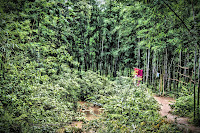Sometimes, I think I might tip too much. When I returned to
Yangon for my last few hours in Myanmar, my guide was waiting at the airport
and practically started jumping up and down when he saw me. I thought I’d just
be going from the domestic airport over to the international terminal to wait
for my flight to Bangkok, but because I had such a long layover, the guide and
driver wanted to take me to a few last sites.
It was almost like they trusted me now and wanted to show me
a darker side of Yangon because the last two sites we visited left me feeling a
bit uneasy. First, we went to see the rare white elephants. These white
elephants were found by the former military government, and they are considered
symbols of power and good fortune, so they were put on display in a public
garden. Five elephants stood chained to a cement display area. They rocked from
side to side and paced one step forward, one step back. The chains were heavy,
short, and tight, and you could see the scars left on their legs from these
torturous leashes. I love animals, but I’ve never been a sappy animal rights
person. Seeing this, though, seriously made my heart heavy with sorrow. The
elephants were so obviously in pain, but there was nothing to be done to help.
My guide said that he hates coming to this place because it makes him sad to
see such beautiful animals suffering.
 The next stop was one last pagoda. This particular pagoda
was relatively new though, and most of it had been built by various members of
the military government. Everything was a display of the virtuous and generous nature
of the generals. The sad thing about this site, however, was not the source of
its
The next stop was one last pagoda. This particular pagoda
was relatively new though, and most of it had been built by various members of
the military government. Everything was a display of the virtuous and generous nature
of the generals. The sad thing about this site, however, was not the source of
its
Heading back to the airport, we stopped for a quick drink,
and my guide gave me a small gift to remember him. It was a very colorful local
style bag, and he said, “I don’t think you will use this, but I hope you will
keep it as a souvenir.” He escorted me into the airport and then gave me a big
hug before saying goodbye.
Myanmar was such an amazing country, and I’m so glad I had
the opportunity to visit, and I hope to return again soon. I fear that the
country may be changing too fast for its own good, and the people may slowly
lose touch with the rich culture that makes this place so unique. After the countless
pagodas, markets, and monasteries, I can safely say that as incredibly
beautiful as this country is, its people are the most beautiful element of all.
I won’t soon forget their smiles, gentle eyes, and warm presence.





























